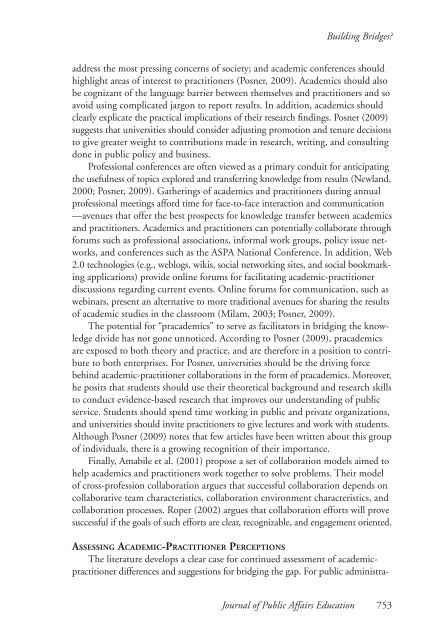Building Bridges? An Assessment of Academic and Practitioner ...
Building Bridges? An Assessment of Academic and Practitioner ...
Building Bridges? An Assessment of Academic and Practitioner ...
You also want an ePaper? Increase the reach of your titles
YUMPU automatically turns print PDFs into web optimized ePapers that Google loves.
<strong>Building</strong> <strong>Bridges</strong>?address the most pressing concerns <strong>of</strong> society; <strong>and</strong> academic conferences shouldhighlight areas <strong>of</strong> interest to practitioners (Posner, 2009). <strong>Academic</strong>s should alsobe cognizant <strong>of</strong> the language barrier between themselves <strong>and</strong> practitioners <strong>and</strong> soavoid using complicated jargon to report results. In addition, academics shouldclearly explicate the practical implications <strong>of</strong> their research findings. Posner (2009)suggests that universities should consider adjusting promotion <strong>and</strong> tenure decisionsto give greater weight to contributions made in research, writing, <strong>and</strong> consultingdone in public policy <strong>and</strong> business.Pr<strong>of</strong>essional conferences are <strong>of</strong>ten viewed as a primary conduit for anticipatingthe usefulness <strong>of</strong> topics explored <strong>and</strong> transferring knowledge from results (Newl<strong>and</strong>,2000; Posner, 2009). Gatherings <strong>of</strong> academics <strong>and</strong> practitioners during annualpr<strong>of</strong>essional meetings afford time for face-to-face interaction <strong>and</strong> communication—avenues that <strong>of</strong>fer the best prospects for knowledge transfer between academics<strong>and</strong> practitioners. <strong>Academic</strong>s <strong>and</strong> practitioners can potentially collaborate throughforums such as pr<strong>of</strong>essional associations, informal work groups, policy issue networks,<strong>and</strong> conferences such as the ASPA National Conference. In addition, Web2.0 technologies (e.g., weblogs, wikis, social networking sites, <strong>and</strong> social bookmarkingapplications) provide online forums for facilitating academic-practitionerdiscussions regarding current events. Online forums for communication, such aswebinars, present an alternative to more traditional avenues for sharing the results<strong>of</strong> academic studies in the classroom (Milam, 2003; Posner, 2009).The potential for “pracademics” to serve as facilitators in bridging the knowledgedivide has not gone unnoticed. According to Posner (2009), pracademicsare exposed to both theory <strong>and</strong> practice, <strong>and</strong> are therefore in a position to contributeto both enterprises. For Posner, universities should be the driving forcebehind academic-practitioner collaborations in the form <strong>of</strong> pracademics. Moreover,he posits that students should use their theoretical background <strong>and</strong> research skillsto conduct evidence-based research that improves our underst<strong>and</strong>ing <strong>of</strong> publicservice. Students should spend time working in public <strong>and</strong> private organizations,<strong>and</strong> universities should invite practitioners to give lectures <strong>and</strong> work with students.Although Posner (2009) notes that few articles have been written about this group<strong>of</strong> individuals, there is a growing recognition <strong>of</strong> their importance.Finally, Amabile et al. (2001) propose a set <strong>of</strong> collaboration models aimed tohelp academics <strong>and</strong> practitioners work together to solve problems. Their model<strong>of</strong> cross-pr<strong>of</strong>ession collaboration argues that successful collaboration depends oncollaborative team characteristics, collaboration environment characteristics, <strong>and</strong>collaboration processes. Roper (2002) argues that collaboration efforts will provesuccessful if the goals <strong>of</strong> such efforts are clear, recognizable, <strong>and</strong> engagement oriented.Assessing <strong>Academic</strong>-<strong>Practitioner</strong> PerceptionsThe literature develops a clear case for continued assessment <strong>of</strong> academicpractitionerdifferences <strong>and</strong> suggestions for bridging the gap. For public administra-Journal <strong>of</strong> Public Affairs Education 753
















